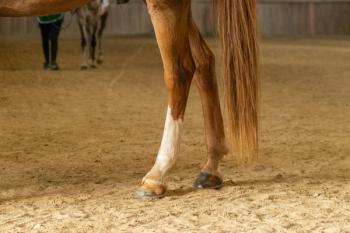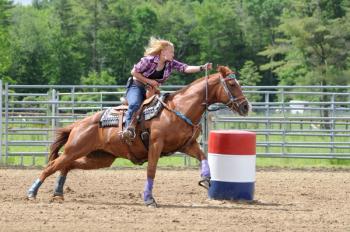
Antimicrobial pharmacology (Proceedings)
Therapeutic decision making is often a difficult and complex process.
Therapeutic decision making
- Often a difficult and complex process
- Often confusing and contradictory information (researchers, horse owners, websites & list serve's)
- Frequently our decisions are based on:
- Our last successful case
- Our last failure
- Our last case
Pharmacological Considerations
- Target
- Mechanism of action
- Route of delivery
- Disposition
- Metabolism/ elimination
- Potential for toxicity
Operant Conditioning
A Historical Perspective
- An ancient peasants house burned down. In it was his pig. When the peasant became hungry enough he tasted the cooked pig and reported its flavor to be miraculous.
- Thereafter, when the villagers wanted to eat roast pig they put one in a house and burned it down.
- Pharmacokinetics
What the body does to the drug
Describes the movement of drugs in the body
- Absorption
- Distribution
- Metabolism
- Elimination
Clinical pharmacokinetics is important for formulating dosage regimens in animals with disease
Pharmacodynamics
What the drug does to the body
Describes the action of the drug on the body- typically related to:
- Plasma/serum concentrations (window into the body)
- Exceptions: Macrolides for respiratory disease & other compounds that are 'tissue-loving'
Values poorly defined in horses- we extrapolate desired 'dose' from human or small animal lit.
Drug concentration in the blood stream usually proportional to drug concentration at site of action
Identify the agent
1. Gram stain (+) (-)
2. disk diffusion test; susceptible, intermediate, resistant. (based on human serum concentrations)
3. MIC - more expensive but more info. resistance often a concentration phenom. (minimum concentration of an AB that inhibits growth of a pathogen in vitro)
Kirby-Bauer susceptibility test
Inexpensive & considerable experience in vet.med.
Disadvantage- difficult to standardize, information on relative susceptibility hard to interpret (accurate??) and temptation to choose drug with largest zone (appropriate?)
Tube dilution MIC
- S = Antimicrobials that are most likely to work
- I = Antimicrobial that might work if pharmacokinetics and dosing are right.
- R = Antimicrobial that should not be used
- Automated, excellent accuracy & repeatability, more information on 'relative susceptibility'
- Disadvantages; more expensive and impractical for small labs
MIC for ampicillin- isolate 1= S for soft tissue & urinary tract, isolate 2= I for soft tissue S for UT, isolate 3= R for soft tissue and UT
Break-point MIC
- Similar to Tube dilution MIC but fewer concentrations
- Less expensive (more drugs/plate)
- More accurate than disk diffusion
- Results available sooner (6-12 hrs) than agar diffusion (24hrs)- automated
- Disadvantages= separate plates for blood, tissues etc..& can not discriminate relative susceptibility in S & R range
Breakpoint MIC for 3 AB's; Ampicillin= R, Cephalothin= I, and Gentamicin= S
Antibiotic Selection
- Spectrum of Activity (Gram + or Gram -)
- Microbial Effect (Cidal or Static)
- Bacterial Killing (concentration vs. time dependent)
- Post-Antibiotic Effect (aminoglycosides and fluoroquinolones)
Time dependent vs. Concentration dependent
Time Dependent drugs
- Concentrations need to be above MIC in the body for prolonged period...
- Beta-lactams
- Sulfonamides
- tetracyclines
Concentration dependent drugs
- High peak conc. Associated with > clinical efficacy
- Aminoglycosides
- fluoroquinolones
Post-antibiotic effect
- Continued inhibition of bacterial growth after drug levels fall below MIC (not well understood)
- Drug may not have to be administered as often or as long as other drugs
- Fluoroquinolones
- Aminoglycosides
Activity considerations
- The distinction between cidal and static is not always exact.
- Cidal drugs- high peaks are important.
- Static drugs- must maintain plasma conc.
- In conditions where patient is immuno- suppressed (neonates, pleuritis..) cidal AB's are preferable.
Dose considerations
- Host defenses determine urgency of therapy
- Immunocompromise (neonates)= bacteriocidal, High peak concentrations
- Trough concentrations imperative for aminoglycosides (nephro & oto- toxic)
Interval Considerations
- Optimum dose interval = sum of "time required for most effective kill" + "duration of PAE's"
- No method for calculating optimum interval
- Duration of therapy
- Too short = therapeutic failure
- Too long = increase risk of adverse drug events and increase resistance in bacterial population
- "Treat 3 days past the end of clinical signs"
- Clinician experience & accepted practice
"Getting the drug into the horse??"
- Oral administration- many challenges...
- Absorption & tissue distribution determined by drug & species factors (most information defined in humans).
- Generally not ideal in horses
- Drug solubility; gastric pH, particle size, fluid volumes, feed in the stomach etc...
Per Os in the Hoss
- Gastric pH very variable (1.0 to 7.5) with periods of spontaneous alkalinization...
- Volume of fluids in GI tract; humans=5-10L per day total; horses=24L/day + 1.6L/hr of gastric, duodenal & pancreatic secretions
- Feeding- changes pH, alters gastric emptying and GI motility, > secretion of bile
- < oral absorptions noted with sulfa's, doxycycline, rifampin, erythomycin
Drug Permeability
- Solubilized drug transported (paracellular or transcellular) across intestinal membrane to systemic circulation.
- Complex process- movement through lipid bilayer w/ 4 distinct regions of differing H2O and lipid content.
- Most drugs cross transcellular (passive diffusion)
- Active transport mechanism for some drugs with limited permeability (B-lactams)
- Cephalexin- great active transport in some species- NOT so in horses???
Other factors affecting absorption...GI Disease:
- Colitis results in > transit time = < drug absorbed
- SI obstructive dz > contact time & > absorption
- IR injury= low blood perfusion < drug absorbed
- Alteration in gut microflora- affects drug metabolism and alters bioavailability...
Tissue Distribution
- After the AB is absorbed into circulation- active concentrations MUST reach the site of infection for successful Tx. [Easier said than done!!]
- Requires therapeutic conc of active drug in extracellular space
- Must penetrate tissue barriers (i.e. bood/brain, blood/ocular)
- Tissue Distribution- Interstitial fluid
- ONLY the unbound fraction of a drug is pharmacologically active
- Concentration of AB's in the ISF is a primary indicator for successful Tx
- Plasma protein binding provides reliable estimate of free drug conc in ISF- more predictive of tx success than total plasma conc
- What do tissue concentrations really mean?
- Drug is in the tissue (doesn't really mean drug is in contact with the bacteria)
- If concentrations are higher in tissue than plasma- drug is bound either intra or paracellular
- Local concentration gradient in ISF may occur as drug leaches out of cells
- Generally- ISF concentration of free drug will match free drug concentration in plasma
- Where are the microbes? Intra or extra cellular?
Reasons for Therapeutic Failure
- Wrong diagnosis
- Wrong drug for infection
- Mixed infection
- Resistant strain of bacteria
- Incorrect dosage
- Noncompliance w/ prescribed regimen
- Drug-Drug interaction
- Concurrent underlying disease
- Drug toxicity or adverse effect
- Immune suppression
- Inadequate duration of therapy
Newsletter
From exam room tips to practice management insights, get trusted veterinary news delivered straight to your inbox—subscribe to dvm360.






